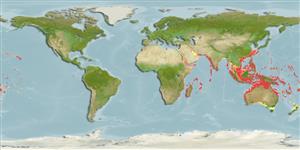Common names from other countries
Environment: milieu / climate zone / depth range / distribution range
Ecologia
marino associati a barriera corallina; non migratori; distribuzione batimetrica 5 - 210 m (Ref. 9710), usually 5 - 30 m (Ref. 90102). Subtropical; 30°N - 30°S
Indo-Pacific: Red Sea and South Africa to warm-temperate Australia and the Hawaiian Islands.
Size / Peso / Age
Maturity: Lm ? range ? - ? cm
Max length : 21.0 cm TL maschio/sesso non determinato; (Ref. 48636)
Short description
Chiavi di identificazione | Morfologia | Morfometria
Spine dorsali (totale) : 12 - 13; Raggi dorsali molli (totale) : 23 - 25; Spine anali: 3; Raggi anali molli: 17 - 19.
Occur primarily along outer reef slopes, in current channels. Juveniles in aggregations around isolated patch reefs, adults in large schools well above the bottom (Ref. 9710). In Indonesia, adults most common in depth 40-50 m, reported to 200 m (Ref. 48636). Benthopelagic (Ref. 58302). Feed on plankton. Juveniles may act as cleaners (Ref. 9710); also observed in adults (Ref. 48636). Oviparous (Ref. 205). Form pairs during breeding (Ref. 205).
Life cycle and mating behavior
Maturities | Riproduzione | Spawnings | Egg(s) | Fecundities | Larve
Form pairs during breeding (Ref. 205).
Myers, R.F., 1991. Micronesian reef fishes. Second Ed. Coral Graphics, Barrigada, Guam. 298 p. (Ref. 1602)
IUCN Red List Status (Ref. 130435)
CITES (Ref. 128078)
Not Evaluated
Threat to humans
Harmless
Human uses
Pesca: di nessun interesse; Acquario: Commerciale
Strumenti
Special reports
Download XML
Fonti Internet
Estimates based on models
Preferred temperature (Ref.
115969): 19.1 - 28.1, mean 26.1 (based on 501 cells).
Phylogenetic diversity index (Ref.
82804): PD
50 = 0.5039 [Uniqueness, from 0.5 = low to 2.0 = high].
Bayesian length-weight: a=0.02239 (0.01117 - 0.04486), b=3.02 (2.85 - 3.19), in cm Total Length, based on LWR estimates for this (Sub)family-body shape (Ref.
93245).
Trophic level (Ref.
69278): 3.3 ±0.40 se; based on food items.
Resilienza (Ref.
120179): Alto, tempo minimo di raddoppiamento della popolazione meno di 15 mesi (Preliminary K or Fecundity.).
Fishing Vulnerability (Ref.
59153): Low vulnerability (11 of 100).
